WP1. MOLECULAR MECHANISMS IN THE DYSFUNCTION OF RELEVANT ORGANS IN THE CONTROL OF INSULIN SENSITIVITY.
LI 1: Identification of mediators and molecular mechanisms in the intra- and extrahepatic interactome in insulin resistance (IR) associated with obesity.
- Coordinator: HEPIR
- Participants: GESTOBES, METABOALL, and DIABEHEART-DIABEMAC
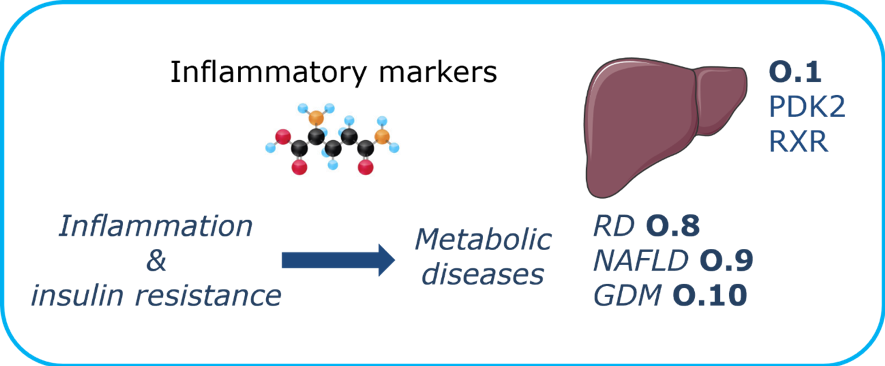
Objectives:
- Study the effect of short-chain fatty acids (SCFAs) derived from intestinal bacterial metabolism on the production and composition of EVs by colon epithelial cells under physiological and proinflammatory conditions (in vitro studies).
- Study the effect of EVs of intestinal origin on the function and survival of pancreatic β cells (in vitro studies).
- In vivo effects of EVs of intestinal origin on the function and survival of pancreatic β cells: approaches in two murine models of diet-induced IR or insulin receptor deletion in the liver.
LI 2: Identification of new molecules in cardiac dysfunction in insulin resistance situations and associated molecular mechanisms.
- Coordinator: DIABEHEART-DIABEMAC
- Participants: GESTOBES, METABOALL, and HEPIR
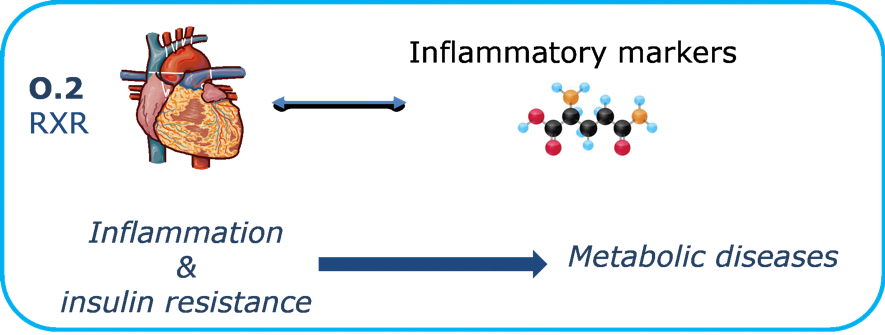
Objectives:
- Study the functional impact of RXR in the adult heart: phenotypic evaluation of the cardio-specific RXR-deficient mouse model.
- Characterize the molecular mechanism by which RXR controls the metabolic homeostasis of the adult heart.
- Investigate the impact of RXR on mitochondrial dysfunction as an underlying mechanism of diabetic cardiomyopathy.
LI 3: Identification of new molecules in renal dysfunction in IR situations: associated molecular mechanisms.
- Coordinator: LIPOBETA
- Participants: GESTOBES, METABOALL, and HEPIR
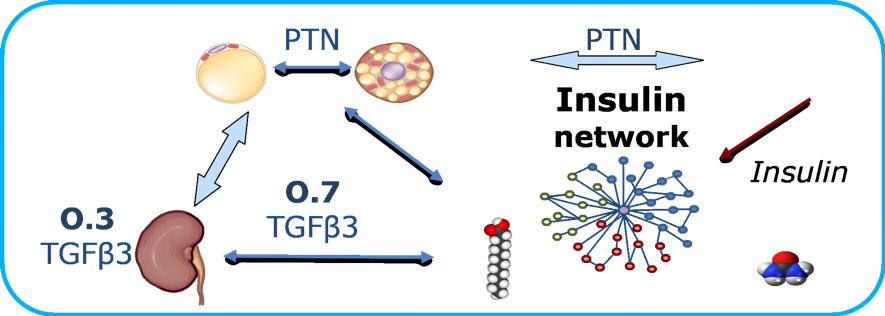
Objectives:
- Investigate the role of TGFβ3 in the development of fibrosis associated with the imbalance between de novo lipogenesis and fatty acid oxidation leading to cellular apoptosis.
- Investigate the role of TGFβ3 in the development of fibrosis associated with inflammation processes.
- Investigate the role of TGFβ3 in the development of fibrosis associated with ER stress and oxidative stress.
LI 4: Cardiovascular complications associated with insulin resistance: role of nuclear receptors in diabetic cardiomyopathy.
- Coordinator: GESTOBES
- Participants: LIPOBETA, METABOALL, and HEPIR
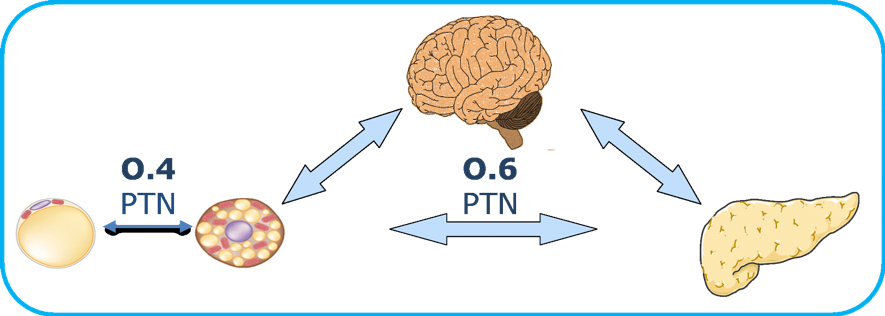
Objectives:
- Study the involvement of PTN in adipose tissue inflammation associated with IR in obesity.
- Molecular characterization of the PTN-mediated signaling pathway and its possible counterregulation by midkine in adipose tissue inflammation associated with IR in this endocrine organ.
WP2: IDENTIFICATION OF MECHANISMS IN THE DYSFUNCTION OF RELEVANT AXES AFFECTING INSULIN SENSITIVITY.
LI 1: Study of communication mechanisms of the entero-insular axis in states of insulin resistance.
- Coordinator: ENTEROBETA
- Participants: LIPOBETA, METABOALL, and DIABEHEART
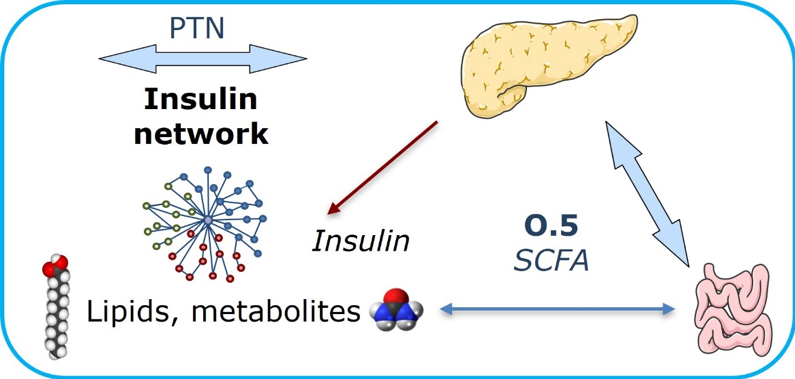
Objectives:
- Study the involvement of PTN in adipose tissue inflammation associated with IR in obesity.
- Molecular characterization of the PTN-mediated signaling pathway and its possible counterregulation by midkine in adipose tissue inflammation associated with IR in this endocrine organ.
LI 2: Neuro-insular-adipose axis: implication of pleiotrophin in the connection of peripheral metainflammation associated with obesity with neuroinflammation.
- Coordinator: GESTOBES
- Participants: ENTEROBETA, METABOALL, and HEPIR
Objectives:
- Study the role of PTN in insulin signaling and central nervous system metabolism in obese mice.
- Analyze the circulating secretome in a diet-induced obesity model in mice.
- Study the effects of PTN on the secretome of adipocytes, pancreatic beta cells, and neurons.
LI 3. Study of communication mechanisms of the adipose-renal axis: effect of adipose tissue secretome on obesity and IR-associated chronic kidney disease.
- Coordinator: LIPOBETA
- Participants: ENTEROBETA, METABOALL, and DIABEHEART-DIABEMAC
Objectives:
- Evaluate the secretory structure and function of adipose tissue in TGFβ3+/male and female mice under normal and high-fat diet conditions.
- Study the gene/protein profile of adipokine and estrogen receptors in the kidney of TGFβ3+ mice.
- Study the interaction of adipokines, miRNAs contained in EVs, and steroid sex hormones in the TGFβ3 signaling pathway and its role in obesity-associated kidney fibrosis.
WP3. TRANSLATIONAL APPROACH IN METABOLIC SITUATIONS THAT PRESENT INSULIN RESISTANCE
LI 1: Identification of new biomarkers in obesity-associated chronic kidney disease.
- Coordinator: LIPOBETA
- Participants: ENTEROBETA, METABOALL, and HEPIR
Objectives:
- Identify EV miRNAs, metabolites, lipids, and proteins in serum and urine samples as biomarkers for the development of nephropathy during the progression of obesity-associated IR.
- Characterize the newly identified biomarkers and study their involvement in the development of obesity-associated nephropathy and the effect of potential treatments (bariatric surgery and an anti-obesity drug).
- Validation in a line of human podocytes of the functional role of lipidomic, metabolic, and proteomic networks, as well as the identified miRNAs in obese patients with chronic kidney disease.
LI 2: Impact of plasma EVs from individuals with NAFLD on the liver-pancreas axis.
- Coordinator: HEPIR
- Participants: ENTEROBETA and METABOALL
Objectives:
- Isolate and characterize circulating EVs from a cohort of individuals with different stages of NAFLD (from fatty liver to fibrosis).
- Investigate whether the lipotoxic/inflammatory cargo of circulating EVs from individuals with NAFLD has a deleterious impact per se on a healthy liver.
- Understand the effect of EVs from individuals with NAFLD on the pancreas.
LI 3: Search for early biomarkers of gestational diabetes.
- Coordinator: GESTOBES
- Participants: DIABETEHEART-DIABEMAC and METABOALL
Objectives:
- Validation of the rs10830963 and rs1387153 polymorphisms of the MTNR1B gene in a cohort of pregnant women to complete the semiological study of these potential early biomarkers of gestational diabetes.
- Identification of other biomarkers of gestational diabetes (EV miRNAs, and metabolites, in serum samples).